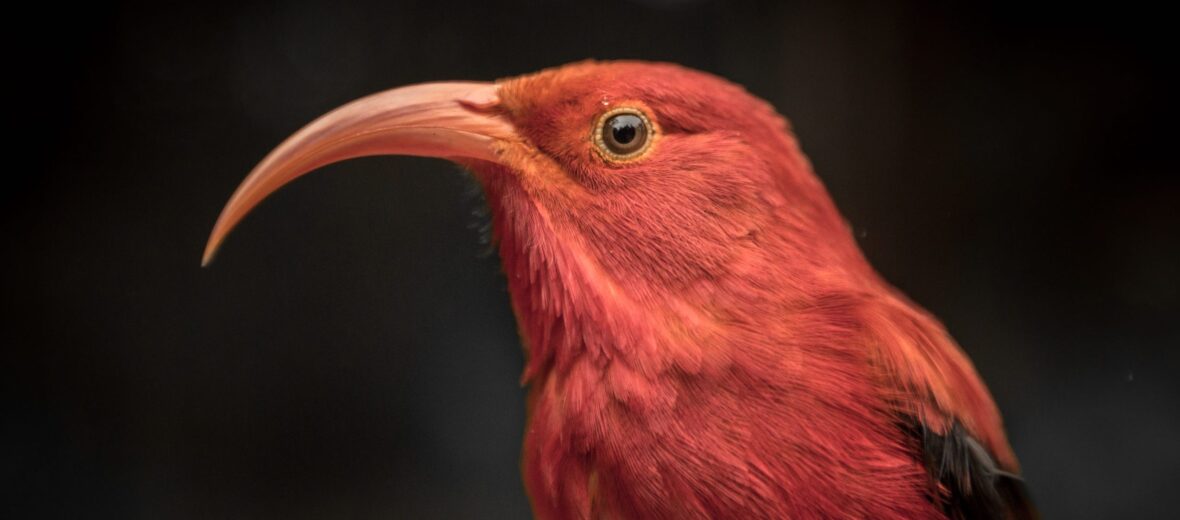
The Hawaiian honeycreeper is a model in adaptive radiation (evolution that occurs when an organism adapts to new environments through genetic mutation). These birds can be found throughout the Hawaiian islands. They prefer tropical to semi-tropical habitats with an abundance of flowers. These birds face many threats like habitat destruction and loss at the hands of residential and commercial development, deforestation, and agriculture; hunting; trapping; invasive species (and with them disease and predation); and climate change (causing habitat alteration). Hawaiian honeycreepers are listed as Vulnerable by the IUCN. Their numbers of an estimated 500,000 – based on the species, are also decreasing. This article is on special request from Eleanor.
First the Stats…
Scientific name: Drepanis coccinea and others
Weight: Up to 1.4 ounces
Length: Up to 6.5+ inches
Wingspan: Up to 5.4+ inches
Lifespan: Up to 12 years
Now on to the Facts!
1.) A single finch species (the Eurasian rose finch) ended up in Hawaii millions of years ago and then diversified into over 50 unique species, each filling a special ecological niche. This is even more extravagant than the famed Galápagos finches.
2.) Many honeycreepers, as their name entails, are specialized nectar feeders. They have specialized beaks and brush-tipped tongues that allow them to gain access to tasty nectar. Some even have evolved beaks designed to access specific flowers.
3.) Some of these critters are not nectarivorous (feed on nectar) but rather feast on insects and even nuts. These species too have evolved certain bill types designed for obtaining invertebrates or for cracking open nuts.
4.) They come in a variety of colors from bright red to shiny green, and everything in between.
5.) Honeycreepers have detailed and melodic songs that are used for communication, territory declaration, and attracting a partner.
But wait, there’s more on the Hawaiian honeycreeper!
6.) These birds have been living on the Hawaiian islands for around 3 million years.
7.) Rats, cats, mosquitoes (which can transmit the deadly avian malaria), introduced birds, and the introduced and invasive brown tree snakes all prey on or trouble these beautiful birds.
Did you know…?
All Hawaiian honeycreepers are found only on the Hawaiian islands, making them a true island endemic species.
8.) Over 20 honeycreeper species have gone extinct since the arrival of humans to the islands.
9.) Praised in native legends, chants, and artwork. They are considered ‘aumakua (ancestral guardians) and their decline has been seen as a sign of not only an ecological but cultural imbalance.
10.) Honeycreepers display a wide variety of social behaviors. Some species are solitary and only come together to mate. Others form breeding pairs or even small family groups. Some even join other species flocks for enhanced foraging and predator awareness.
But wait, there’s still more on the Hawaiian honeycreeper!
11.) Some honeycreeper species, like the Po’ouli for instance, have lost their ability to fly. This has proven disastrous on islands with higher amounts of ground-based predators.
12.) The iconic Kakao was once on the edge of extinction. However, its population has rebounded thanks to intensive conservation efforts.
13.) Protecting honeycreepers and their habitats is also beneficial to local communities via ecotourism. Birdwatchers and nature enthusiasts alike are drawn to Hawaii’s avian species. This generates income and raises awareness at the same time.
14.) These educational Ambassadors serve as important educational tools, not only teaching us about evolution and island ecosystems, but also the importance of conservation of our natural world.
15.) Females typically lay up to 2 eggs that hatch in up to 17+ days. This varies based on the species. The chicks usually fledge in up to 25 days after hatching (again, based on the species).
Now a Short Hawaiian Honeycreeper Video!
Be sure to share & comment below! Also, check out the Critter Science YouTube channel. Videos added regularly!
Want to suggest a critter for me to write about? Let me know here.
Some source material acquired from: Wikipedia & IUCN
Photo credit: Division of Forestry and Wildlife



